Salesforce has officially announced the retirement of two long-standing automation tools—Workflow Rules and Process Builder—as part of its strategic push toward Flow, the unified automation engine for the platform. While these tools served well over the years, their time has passed. The end of support signals not just a technical sunset, but a call for Salesforce leaders to act now, rethink their automation strategy, and unlock greater agility in their operations.
What’s Changing?
As of Winter ’23, Salesforce halted the creation of new Workflow Rules and Process Builders. Starting in 2025, Salesforce will no longer support these legacy tools. While existing automations will continue to run, they won’t receive enhancements, security updates, or compatibility assurances with future platform releases. More importantly, admins and developers are being guided to migrate all existing logic into Flow.
This is not just a product update. It’s a strategic shift.
Why Flow Is the Future
Salesforce Flow is now the platform’s single automation engine, absorbing the capabilities of Workflow Rules, Process Builder, and even some Apex use cases. It supports more complex logic, stronger performance, robust error handling, and modular design through reusable subflows.
From a business perspective, Flow enables:
- Greater agility: Faster build-test-deploy cycles for automations.
- Stronger governance: Consistent documentation and auditability.
- Improved performance: Leaner, more maintainable orgs.
For executive teams, transitioning to Flow is not just best practice—it’s how you future-proof your Salesforce investment.
The Risk of Delay
Delaying your migration to Flow exposes your organization to multiple risks:
- Breakage: Unsupported automation may fail with future Salesforce updates.
- Cost: Legacy logic creates technical debt and bloats maintenance.
- Compliance: Outdated tools raise red flags under regulatory scrutiny.
- Complexity: The longer you wait, the more tangled your automation layer becomes.
Other Features Are Going Away Too
While Workflow Rules and Process Builder are in the spotlight, they aren’t the only features on Salesforce’s retirement roadmap. Other tools and configurations—including some API versions, permission sets, and UI components—are also being deprecated. These changes may not be as widely discussed, but they can have just as much impact on your business-critical processes.
That’s why it’s essential to not just fix one issue—but stay ahead of the entire platform evolution.
Why a Managed Services Partner (MSP) Matters
With these rapid changes, many internal teams struggle to keep up. A Salesforce Managed Services Partner can:
- Continuously monitor the Salesforce roadmap and identify upcoming deprecations.
- Proactively audit and migrate vulnerable components, not just automation.
- Offer cross-functional expertise in Flow, DevOps, Apex, and more.
- Provide strategic planning to align your Salesforce roadmap with business goals.
At Palladin Technologies, we’ve helped clients of all sizes manage migrations from legacy tools to future-ready architectures—with minimal disruption and maximum ROI.
What Leaders Should Do Now
As an executive, your role is to sponsor and enable this transformation. Here’s where to start:
- Assess your footprint: Request a comprehensive audit of automation and other deprecated features in your org.
- Prioritize mission-critical processes: Focus on automations tied to revenue, compliance, and customer experience.
- Budget strategically: Treat the migration as a modernization initiative—not just a cleanup task.
- Empower your team: Invest in training or bring in a strategic partner to accelerate and guide the effort.
The Bottom Line
Salesforce’s shift toward Flow—and away from legacy tools—is not optional. It’s a new foundation for how the platform will work going forward. Forward-looking leaders who take action now will:
- Reduce risk
- Improve performance
- Ensure ongoing compatibility
- Set the stage for scalable growth
And with the right partner, you can make that leap with confidence.
Ready to future-proof your Salesforce org? Let’s talk.
